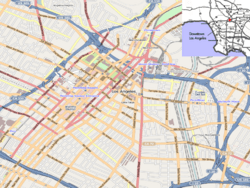Civic Center, Los Angeles facts for kids
Quick facts for kids
Civic Center
|
|
|---|---|

Los Angeles City Hall stands at the southern border of the Los Angeles Civic Center
|
|
| Country | |
| State | |
| County | |
| City | |
| Area code(s) | 213 |
The Civic Center is a special neighborhood in Los Angeles, California. It's like the main office for the City of Los Angeles and Los Angeles County. Here, you'll find many important buildings. These include offices and courthouses for the city, county, state, and even the U.S. federal government. This area was once the main business district of Los Angeles in the late 1800s.
Contents
Where is the Civic Center Located?
The Civic Center is in the northern part of Downtown Los Angeles. It's next to other cool neighborhoods like Bunker Hill, Little Tokyo, and Chinatown.
This area has the most government workers in the United States. Only Washington, D.C. has more. This is because Los Angeles County has the most people in the U.S. Also, Los Angeles is the second-largest city. So, many state and federal offices are needed here.
Other Government Centers in Los Angeles
Los Angeles has grown a lot. Because of this, the city created other smaller government centers. These are located in different parts of the city.
- The West Los Angeles Civic Center is in the Westside. It was built between 1957 and 1965.
- The Van Nuys Civic Center is in the San Fernando Valley.
- There's also a neighborhood city hall in San Pedro.
Getting Around: Transportation
It's easy to get to the Civic Center using public transportation. The Regional Connector train line helps people get around. It opened on June 16, 2023. This line has two stations that serve the area.
- Grand Avenue Arts/Bunker Hill station
- Historic Broadway station
History and Planning of the Civic Center
The Civic Center sits on what used to be the main business area of Los Angeles. This was back in the 1880s and 1890s. Over time, newer businesses moved south. The older blocks became less important.
Many people had big plans for a modern Civic Center. Different architects and planners shared their ideas. They wanted to create a clear, organized government area. In the late 1920s, people voted to confirm the location. But the city and county couldn't agree on one single plan.
Even without one big plan, buildings started to go up. The City Hall and the Hall of Justice were built in the 1920s. The California State Building followed in 1931.
A plan from 1947 helped shape the area. It suggested tearing down the old residential area of Bunker Hill. This happened in the 1950s. It allowed the Civic Center to grow westward. Two new county buildings were built:
- The Stanley Mosk Courthouse (1958)
- The Kenneth Hahn Hall of Administration (1960)
These buildings were placed on either side of a new walking area. This area is now part of Grand Park. The Los Angeles County Hall of Records also opened nearby in 1962.
In 2012, Grand Park was created. It stretches from the Los Angeles Music Center to City Hall. This park is a big green space in the middle of all the government buildings.
The city wants to make the Civic Center more lively. In 2017, a new plan was approved. It aims to connect City Hall with nearby neighborhoods. This includes Little Tokyo. The plan suggests adding shops and cafes on the ground floors of buildings. This will bring more people to the area. The plan also includes new government towers. There's even an idea for a park over Highway 101. This would connect to Union Station and Olvera Street.
Important Buildings and Landmarks
The Civic Center is home to many important buildings. Here are some of them:
- Grand Park is a large park that runs through the center.
Buildings on the West Side
- County departments for Public Health and Health Services.
- Figueroa Plaza, which houses various city departments.
- John Ferraro Building, home to the Los Angeles Department of Water and Power (DWP).
Cultural Buildings
- Ahmanson Theatre (1967)
- Mark Taper Forum (1967)
- Dorothy Chandler Pavilion (1964)
- Los Angeles Music Center (1964)
- Walt Disney Concert Hall
Courthouses and Administration Buildings
- Cathedral of Our Lady of the Angels (2002)
- Stanley Mosk Courthouse (1958)
- Kenneth Hahn Hall of Administration (1960)
- Los Angeles County Hall of Records (1962)
- United States Courthouse (2016)
- Hall of Justice (1925)
- Law Library
- Clara Shortridge Foltz Criminal Justice Center (1972)
- Spring St. U.S. Court House (1940)
- Los Angeles City Hall (1928)
- Los Angeles Police Department Headquarters (2009)
Other Government Buildings
- Los Angeles Mall (1974)
- City Hall East
- Triforium
- City Hall South
- Caltrans District 7 Headquarters
- Los Angeles Federal Building (1965)
- Edward R. Roybal Federal Building
- Alameda Street Detention Facility
- Parker Center (1955, former police headquarters)
Images for kids
-
View of the Civic Center from Dodger Stadium.




